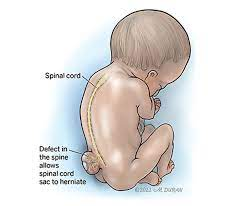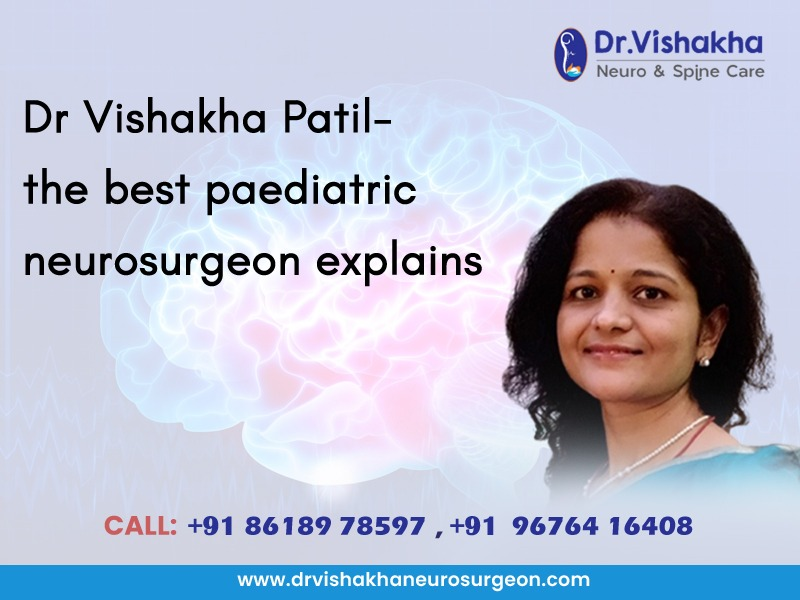Dr Vishakha Patil, a renowned pediatric neurosurgeon, specializes in spina bifida repair and offers advanced surgical techniques and patient-centred care. With over 15 years of experience, she has successfully treated over 1,800 cases involving intricate spinal and neurosurgical procedures for children. Her expertise is particularly notable in the area of myelomeningocele, the most severe form of spina bifida. Dr. Patil emphasizes the importance of early diagnosis, precise surgical interventions, and multidisciplinary care for children with spina bifida. Her expertise is particularly notable in treating complex neurological conditions in children.
Types of Spina Bifida
- Myelomeningocele is a severe form of spinal cord and nerve protrusion, often leading to significant neurological impairment.
- Meningocele is a rare condition where the spinal cord’s protective membranes push out through an opening without including the spinal cord itself.
- Occulta is the mildest form of spinal cord deformity, characterized by a small defect in the bony encasement, often without noticeable symptoms.

Spina Bifida Repair Procedures
Parental surgery
Prenatal repair is a surgical procedure performed during pregnancy, typically between 22-26 weeks, for severe cases like myelomeningocele. Traditional methods involve opening the mother’s abdomen and uterus to expose the fetus, which is then repaired. Minimally Invasive Fetoscopic Surgery, using small incisions and a fetoscope, is less invasive and reduces risks like uterine rupture and preterm birth.
This medication reduces hydrocephalus risk, VP shunts requirement, improves motor function, prevents neurological damage during pregnancy, and minimizes hindbrain herniation linked to Chiari II malformation.
Postnatal repair
Spina bifida repair is typically performed within 24-48 hours of birth to reduce infection risk and protect the spinal cord. The surgeon closes the spine opening, repositions meninges and neural tissues, and covers the defect with muscle and skin. In some cases, synthetic materials or grafts are used to reinforce the closure.
This medication effectively prevents infections like meningitis and CSF leakage by stabilizing the spinal cord and nerves, minimizing further damage.
Innovations and specialized techniques
Robotic-assisted surgery enhances precision and reduces tissue trauma, promoting faster recovery. Bioengineered Patches use synthetic or biological materials to cover defects, reducing scarring and improving outcomes. Endoscopic Surgery uses an endoscope for precise closure of smaller defects.
Hydrocephalus-related repair
Hydrocephalus is a common complication in severe spina bifida cases, particularly myelomeningocele. It often requires separate surgical management. VP Shunt Placement drains excess cerebrospinal fluid from the brain to the abdominal cavity. At the same time, Endoscopic Third Ventriculostomy (ETV) creates an opening in the third ventricle for CSF drainage without a shunt.
Tethered cord syndrome repair
Tethered cord syndrome is a condition where the spinal cord becomes abnormally attached to surrounding tissues, causing stretching and progressive neurological symptoms. Release from adhesions or scar tissue prevents further decline and alleviates pain or motor deficits.
Other supportive surgical interventions
Orthopaedic surgery addresses common spina bifida issues like scoliosis and joint deformities, while urological surgery may be performed for severe bladder dysfunction, such as bladder augmentation or catheterizable channel creation.
Non-surgical management
Non-surgical approaches, such as physical therapy, occupational therapy, Clean Intermittent Catheterization (CIC), and orthotics and assistive devices, are crucial for managing mild cases or post-surgery rehabilitation, enhancing mobility, preventing contractures, improving functional independence, managing bladder dysfunction, and supporting mobility.

Understanding the Causes and Risks
Spina bifida is a condition characterized by abnormalities in the neural tube, a condition that is believed to be caused by genetic, nutritional, and environmental factors. Genetics, such as a family history of neural tube defects, can affect folate metabolism, which is crucial for neural tube development. Nutritional deficiencies, such as low levels of folic acid, are also linked to an increased risk of spina bifida. Chronic health issues, such as diabetes and obesity, are also associated with a higher risk of spina bifida. Additionally, certain medications, like valproate, have been linked to increased neural tube defects during pregnancy.
Long-Term Management
Spina bifida is a neurological condition that affects children, causing hydrocephalus and mobility issues. They require ongoing medical care, rehabilitation services, and early intervention strategies to improve their quality of life. A multidisciplinary approach is necessary, and with proper care, many children with spina bifida can lead fulfilling lives. Awareness of risk factors and early intervention strategies are crucial.
Post-surgery recovery and rehabilitation are crucial for children with spinal bifida repair. Physiotherapy improves mobility and prevents muscle weakness, while occupational therapy aids in daily activities adaptation and independence. Advancements in prenatal and postnatal surgery, regenerative medicine, and multidisciplinary care have improved outcomes. Early diagnosis, individualized treatment plans, and specialized care are essential for optimal long-term outcomes. Advancements in surgical techniques and multidisciplinary care continue to improve patient prognosis, reduce complications, and enhance quality of life.
About Dr Vishakha
Dr. Vishakha Karpe, a highly skilled Senior Paediatric Neurosurgeon at Rainbow Children’s Hospital, Banjara Hills, and Hyder Nagar in Hyderabad, is one of India’s leading paediatric neurosurgeons with extensive experience in paediatric neurosurgery. With over nine years of dedicated practice, she is among the few in India working extensively in this field.
With extensive experience in paediatric neurosurgical conditions, she focuses on comprehensive care, including precise surgery and educating parents about the complete case management protocol. She is an efficient and passionate medical professional, pursuing ethical practice and ensuring patient care after surgery.
Proficiency of Dr Vishaka:
Hydrocephalus (increased fluid in the brain): The procedure involves an endoscopic third ventriculostomy and CSF diversion (VP shunt) to treat complex hydrocephalus.
- Craniosynostosis (abnormal head shape due to untimely cranial sutures fusion) surgeries: Helmet therapy is a technique that is used in both endoscopic and open surgery.
- Spinal dysraphisms(Spina Bifida)- (spinal abnormalities present by birth) – surgical repair
- Encepahaocles repair surgery.
- Vascular conditions and stroke surgeries: revascularization surgeries for moya moya disease.
- Pediatric brain and spine tumour surgeries.
- Pediatric brain and spine infection surgeries: Endoscopic and open surgeries for brain and spine infections.
- Pediatric traumatic brain and spinal injury.
- Antenatal counselling for congenital fatal neurosurgical conditions.
Dr Vishaka specializes in craniosynostosis surgery, which is only done in a few centres in India. Dr Vishaka Patil, M.B.B.S, DNB (AIIMS) New Delhi, M.Ch (IPGMER SSKM) became a Member of “The Royal College of Surgeons, Edinburgh” (U.K.) a highly successful and best pediatric neurosurgeon in Hyderabad, Telangana with 13 years of experience, is among the topmost pediatric neurosurgeons in the Rainbow group of hospitals at Hyder Nagar and Banjara Hills.





